No matter the time of year or the occasion, cinnamon rolls are a special treat. There are few smells more homey, more comforting, more wholesome than freshly baked cinnamon rolls. And that’s just the smell! The rolls themselves blow all that out of the water: sweet, rich, warm, cinnamony. We should all be making them far more often than we are.
Perhaps the reason we don’t make them all the time—relying instead on ersatz instant-rolls or thawed-at-the-store “fresh” ones—is the time commitment and the fear of failure. No one wants to put in the time to make cinnamon rolls and have them come out flat and dense or doughy in the middle. But that needn’t ever happen to you! We have the thermal solutions you need to make sure your cinnamon rolls turn out perfectly every time. So whether you’re making them just for a lazy weekend at home or a special holiday treat, you can have light, sweet, delicious cinnamon rolls every time. Let’s get into it!
Equipment Used in This Post:
Cinnamon roll basics
Cinnamon rolls can come in all sorts of shapes and sizes. They can have nuts or raisins, or just a good filling. they can be tall, pillowy, messy affairs (yum), or (like the ones we’re doing here) easy to grab with one hand—no fork necessary. None of these is any more “right” than another, except for when it comes to personal taste.
No matter the style you make, though, there are a few things that remain the same. The dough, for instance. All the cinnamon roll recipes we’ve ever come across use an enriched dough—one that has fat and sugar added to it. Rich doughs are often sweeter, but because of the added fat (butter) they are also very tender and will stale less quickly.
This recipe uses the richest of doughs—brioche. Brioche (pronounced BRĒ-ôsh) is exceedingly light and tender while also tasting rich and fulfilling. Brioche can be shaped into braids, loaves, or any number of roll shapes; cinnamon rolls are a perfect place to use this dough. (For another example of a brioche, read up on challah bread, which Rose Levy Beranbaum classifies categorically as a brioche.)
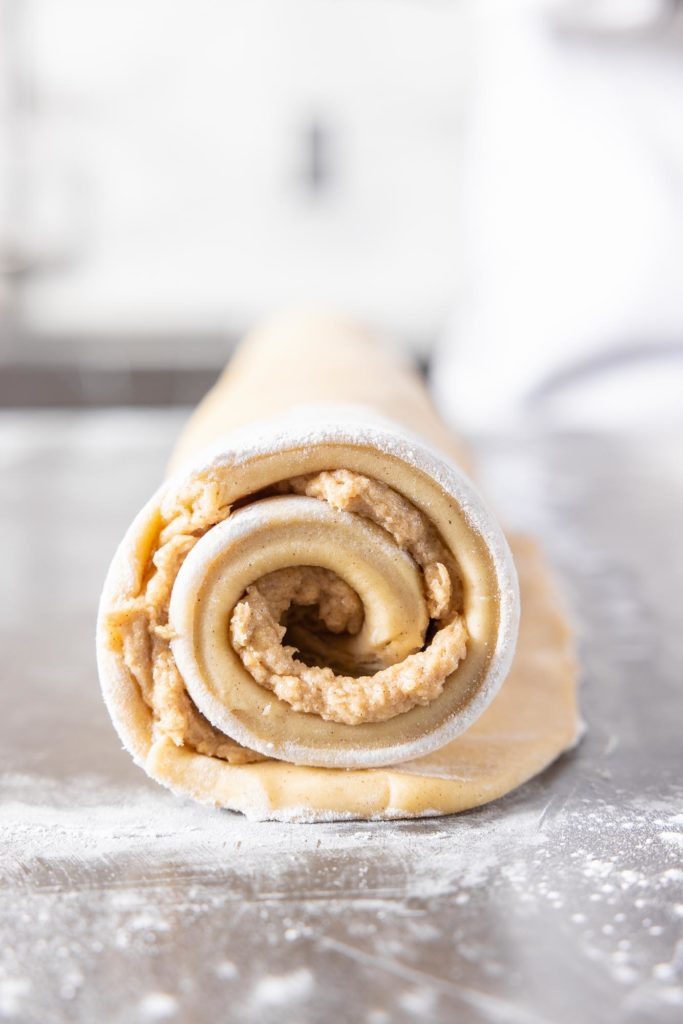
Cinnamon roll icing/frosting
Of course, cinnamon rolls are best when iced, and how you choose to frost yours is a personal preference. Many people use a sweet-rich cream cheese frosting. Others like a simple glaze. You can make one by whisking together 2 cups of powdered sugar and enough cream to make icing that’s just thin enough to drizzle.2
Or you can, as we did, use a light and buttery French buttercream icing—although that icing can’t go on when the rolls are piping hot, or it will melt. Give the rolls a minute to start cooling, then slather it on. Or you can serve the rolls with a bowl of the frosting next to the platter and let people dress them themselves. Then everyone gets as much or as little delicious frosting as they want.
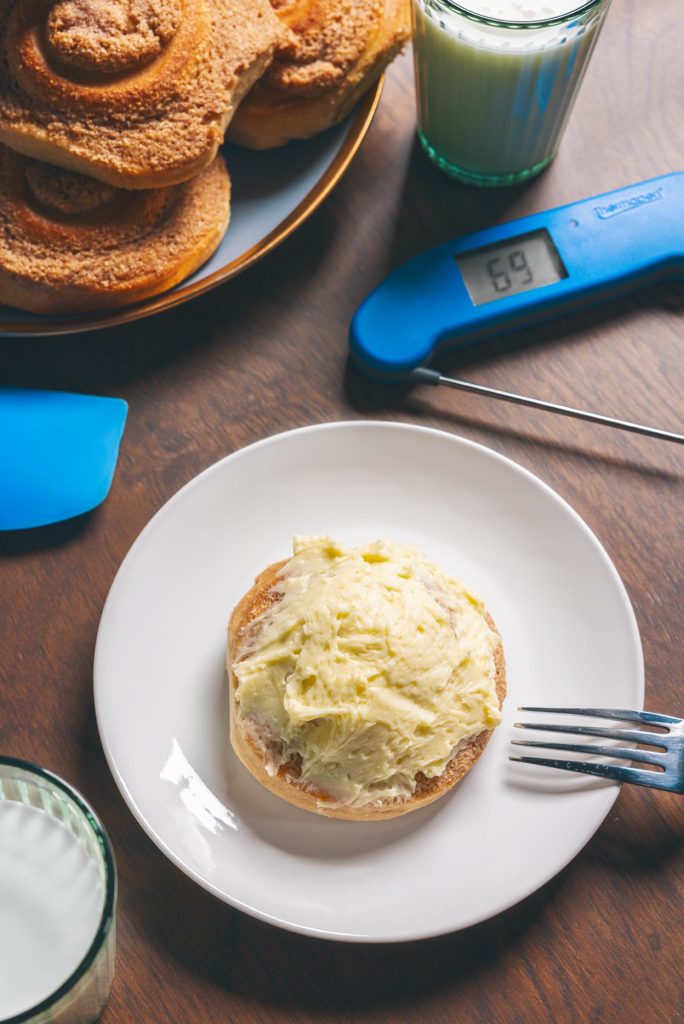
Homemade cinnamon roll temperatures
Brioche Temperature Control
Temperature control is critical from start to finish with this project. As mentioned in our Temperature Tips for Thanksgiving Rolls post, dough temperature directly affects the fermentation process. And because we want our fermentation to go just right, it’s important to control as many thermal factors as we can. For all of the temperature spot-checking in this project, an instant-read digital thermometer is the best tool for the job, and we used our Thermapen® ONE.
Friction Increases Dough Temperature
Making brioche requires a lot of mixing, and mixing creates friction, which increases the temperature of the dough. It’s important that the liquid ingredients and the butter are cold when they are first introduced into the dough, so that the dough’s temperature doesn’t get too high during mixing.
The milk and eggs should be used directly from the refrigerator—36–40°F (2–4°C). The butter needs to be cool but malleable—60–65°F (15–18°C) (verify the butter’s temperature with your Thermapen).
Desired dough temp
When wheat flour is combined with moisture and then mixed, gluten begins to develop. Fat, however, interferes with gluten development and shortens the gluten strands, breaking down the structure that has developed so far. For brioche, gluten is developed first when the dough is made, then the butter is incorporated gradually. The once-tight dough will seem to fall apart as butter is added, but then comes together into a soft, smooth, supple—but loose—dough once all the butter is incorporated.
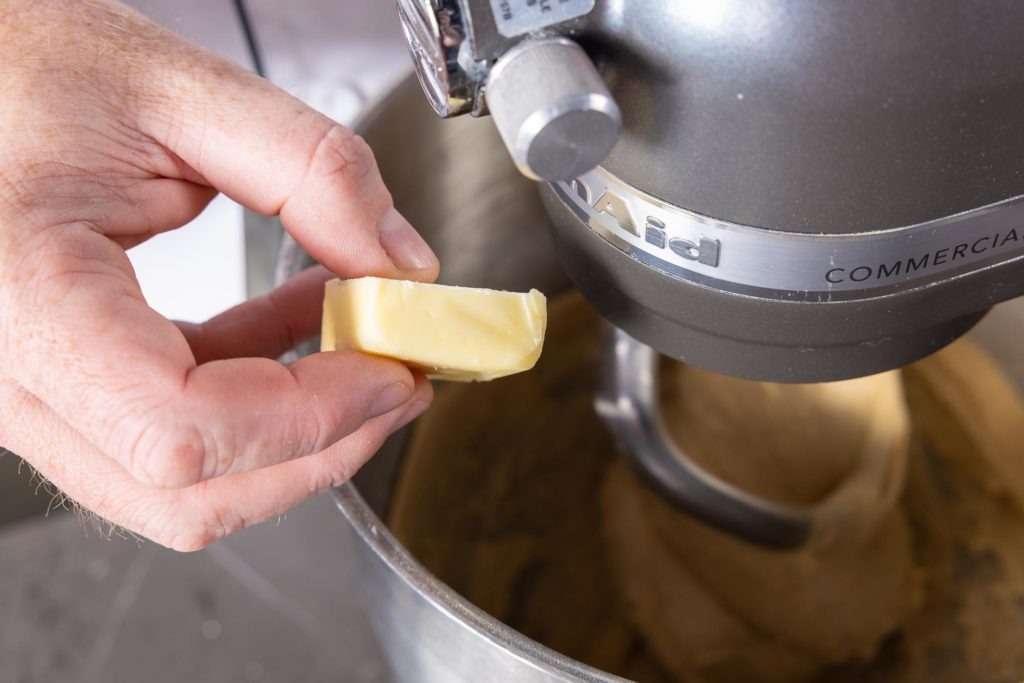
The friction of the mixing will warm the dough. It should end up roughly between 75 and 85°F (24 and 29°C). This will be perfect as the fermentation begins.
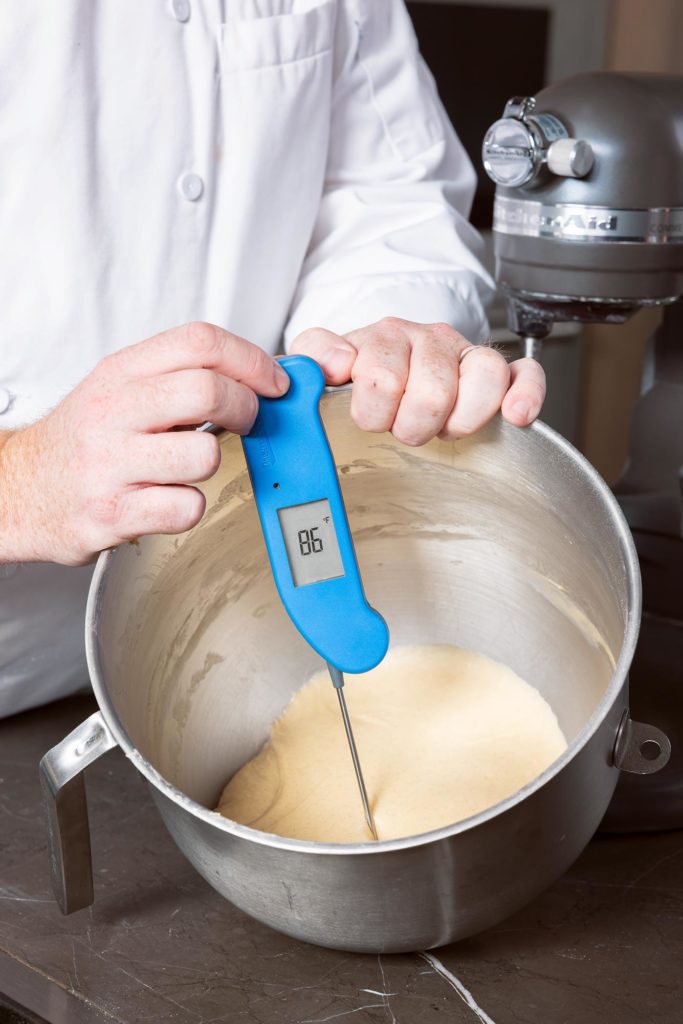
Chilled Fermentation
The dough is next fermented at room temperature—68–75°F (20–24°C)—for an hour, then stretched, folded, and refrigerated overnight (at least 4 hours, but overnight is best). The slower chilled fermentation develops complexity in the dough’s flavor and texture (our Thanksgiving Dinner Rolls post has more information on cold fermentation and its effect on yeast doughs).
Not only do slow-fermented rolls taste better, but the high amount of butter in the dough makes the dough firm when it’s chilled. This makes the dough easier to roll out into a perfect rectangle. And after it’s filled and rolled up, the cinnamon roll log will hold its shape and cut into individual cinnamon rolls much more easily than will dough at room temperature.
Note: sugar slows fermentation in rich doughs
Large amounts of sugar slow the growth of yeast by dehydrating the cells, so sweet doughs are often made with more yeast than ordinary breads, and they may take longer to rise.
—On Food and Cooking, by Harold McGee
That slower-fermenting dough can be frustrating, so giving ourselves the whole night to ferment will ease the stress of a slow dough, in addition to the benefits of chilling.
Cinnamon roll doneness temperature
We talked about the disappointment of finding your cinnamon rolls to be doughy in the middle. But that really doesn’t have to be a problem! It’s easy to know if your cinnamon rolls are done: check their temperature at the thermal center with an instant-read thermometer.
In the category of yeast bread, there are rich doughs and lean doughs, each with their own recommended pull temperature ranges. Rich doughs like brioche should be pulled at an internal doneness temperature of 190–200°F (88–93°C) while lean doughs (such as baguettes and ciabatta) are best pulled at 200–210°F (93–99°C). As these are brioche cinnamon rolls, very rich, they should come out of the oven when their internal temp reaches 190–200°F (88–93°C).
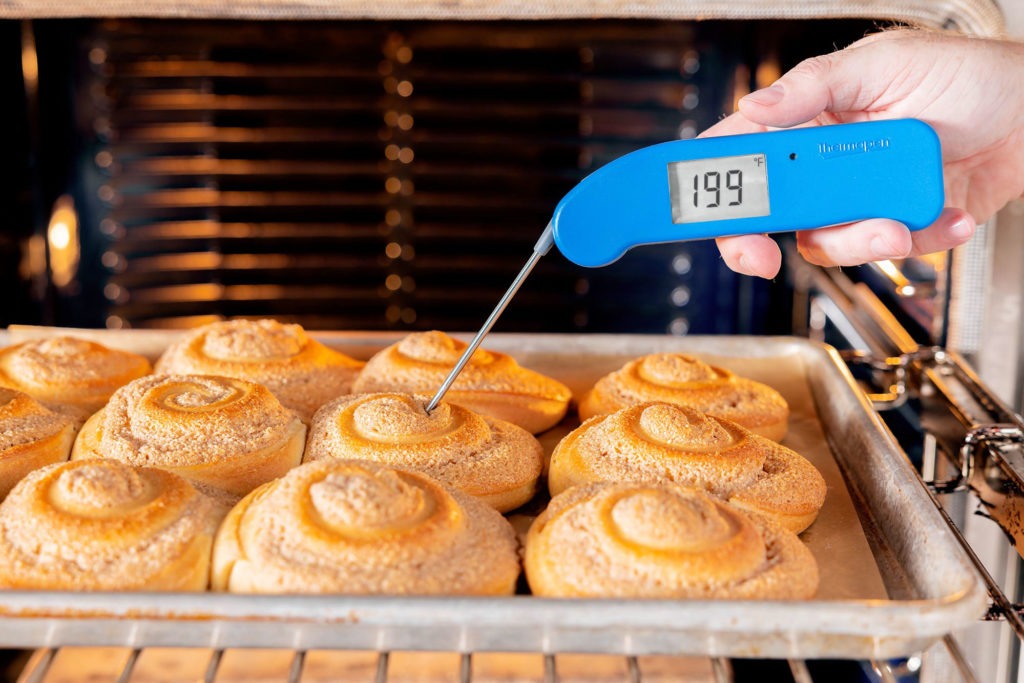
Start checking that temperature after about 15 or 20 minutes of baking using your Thermapen® ONE, and if you don’t find a temperature lower than the recommended pull temp, they’re done!
Once you give brioche a try, you’ll be hooked—after all, it’s bread that is basically pre-buttered. Combine that with the cinnamon-roll form factor here, and you’re getting pretty tasty. Then, to add to the inherent deliciousness of the rolls themselves, remember that with our temperature guidance you’ll have very little trouble getting these rolls right every time, and you suddenly have a dish that is super-repeatable. New family weekend tradition? Yes, please!
Print
Homemade Cinnamon Rolls Recipe
Description
This dough and the filling are adapted from Thomas Keller’s Bouchon Bakery.
Some of the ingredient measurements may seem a little … fiddly, but use a scale and it won’t be a problem.
The frangipane filling is a French classic, and we’ve added cinnamon sugar to it for this recipe. If you have a favorite cinnamon roll filling, feel free to use it!
Ingredients
Brioche Dough
- 3–3/4 C (526 g) all-purpose flour
- 1 tsp ground cinnamon
- 3–1/2 tsp (12 g) instant yeast
- 5 Tbsp (62 g) granulated sugar
- 2 tsp (12 g) salt
- 5 large eggs (enough for 264 g), cold—36–40°F (2–4°C)
- 1/4 C + 4-1/2 tsp (88 g) whole milk, cold—36–40°F (2–4°C)
- 8 oz unsalted butter (227 g), cut into 1/2-inch pieces, malleable—60–65°F (15–18°C)
Cinnamon Filling
This paste spreads on easily and evenly and makes it easy to roll up the dough tightly without it falling apart. You can use your favorite filling if you like!
All ingredients should be room temperature—68–75°F (20–24°C)
- 1 C (125 g) almond flour
- 3–1/2 tsp (12 g) all-purpose flour
- 4–1/2 oz (125 g) butter (1 stick + 1 tablespoon)
- 1 C (125 g) powdered sugar
- 1/4 C whole egg (75 g)—about 1 to 1-1/2 large eggs
- 4 tsp (12 g) ground cinnamon
Instructions
Make Brioche Dough
- Place flour, cinnamon, yeast, sugar and salt into the bowl of a stand mixer and whisk together evenly.
- Add the eggs and milk and mix on low speed with dough hook for 4 minutes (the dough should hold together in a loose ball).
- Gradually add the butter piece by piece, mixing well to incorporate after each piece. The dough will seem to fall apart while mixing in the butter. After all the butter has been added, continue mixing on low to medium-low speed until the dough forms a tight ball around the dough hook again. This process may take 30 minutes. The final dough should be about 75–77°F (24–25°C).
- Transfer dough to an oiled bowl or container and cover. Ferment at room temperature for 1 hour. The dough will not rise very much in this hour.
- Fold the dough by stretching from top, bottom, and either side, then flip the dough over. Cover and refrigerate for at least 4 hours and preferably overnight.
Next Day
Make Cinnamon Filling
- Place the room temperature butter into the bowl of a stand mixer fitted with the paddle attachment and mix on medium speed until the butter is fluffy and light.
- Whisk together the powdered sugar and add to the butter. Mix on low speed until incorporated. Scrape down the sides with a spatula.
- Add the egg and mix on medium speed so the mixture is fluffy. Scrape down the sides of the bowl.
- Add the almond flour, flour, and cinnamon and mix on low speed to combine. Scrape down the sides of the bowl and mix again.
- Set the filling aside while you roll the brioche dough.
Shape
- Pull the brioche dough from the refrigerator. Scrape the dough from the bottom of the container and invert onto lightly floured work surface.
- Roll out into a 12 x 15″ rectangle that is 1/4″-thick.
- Spread the cinnamon filling all over the dough with an angled spatula, leaving a 1″ border on one of the long sides uncovered.
- Lightly moisten the 1″ border of dough with water. Roll up the dough into a log starting with the long edge that has the cinnamon filling spread all the way to the border.
- Pinch the moistened edge of the dough to seal the seam. Shape the log so that its diameter is even all the way across. Position the rolled log so that it’s seam-side down.
- Using kitchen twine, cut 3/4″ slices through the length of the log.
Proof
- Place the cinnamon rolls onto a parchment-lined baking sheet. Lightly spray with cooking spray and cover with plastic wrap.
- Proof (last fermentation after shaping) the cinnamon rolls at room temperature until they have increased in volume, and an indentation springs back when you press the edge of the dough with your finger. You should see and feel that bubbles have developed in the dough.
Bake
- Preheat oven to 350°F (177°C). Once proofed, bake the cinnamon rolls for 20-30 minutes.
- When the cinnamon rolls are lightly golden brown, spot-check their internal temperature with a Thermapen to test their doneness. Their internal temperature should be 190–200°F (88–93°C).
- If the internal temperature is below 190°F (88°C), continue baking for a minute or two longer and spot-check the internal temperature again.
Finish and Serve
Once they’re done, remove them from the oven, allow them to cool somewhat, ice them, and serve!
Shop now for products used in this post:
Resources:
In one of his novels, author Leif Enger talks about using strong coffee to make the glaze instead of cream. We’ve never tried it, but is sounds pretty tasty!↩
In one of his novels, author Leif Enger talks about using strong coffee to make the glaze instead of cream. We’ve never tried it, but is sounds pretty tasty!↩
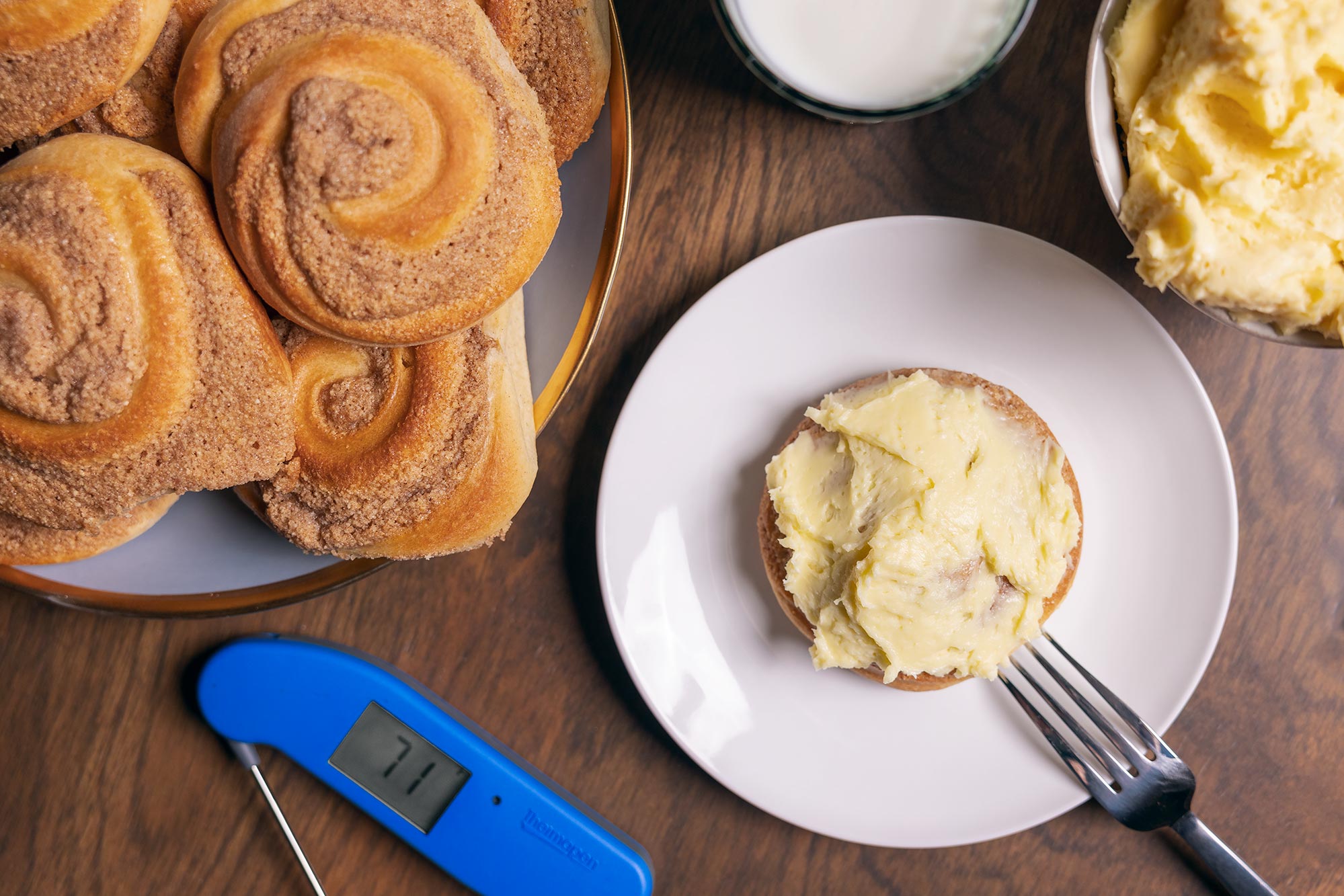
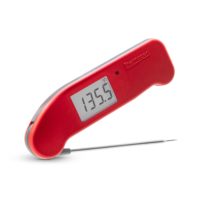
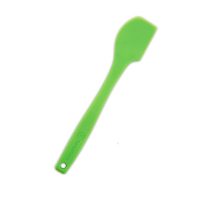
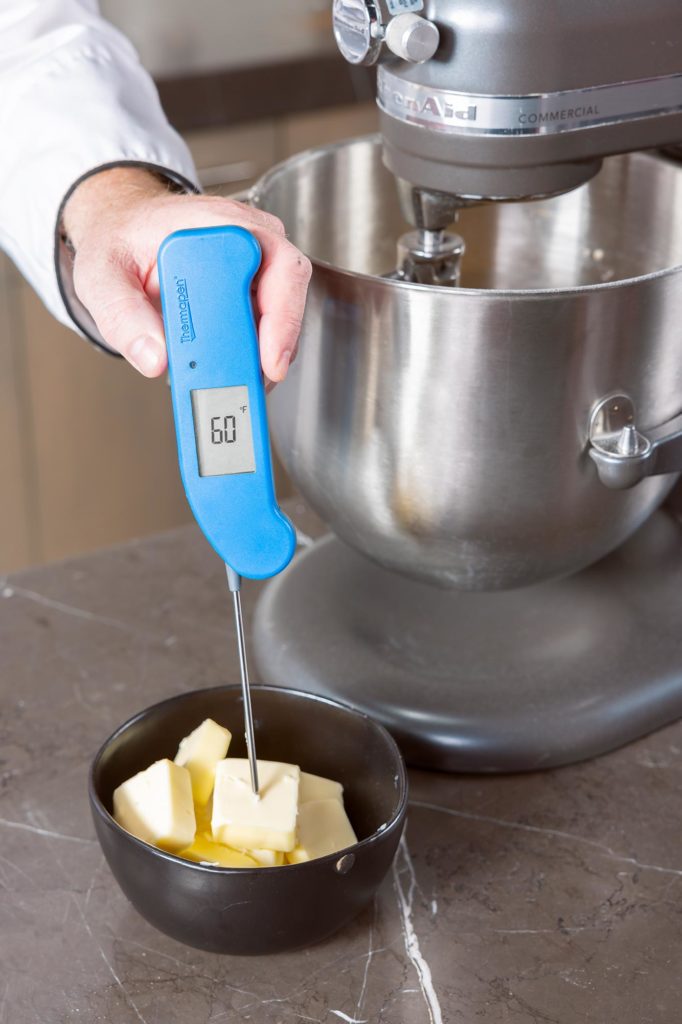
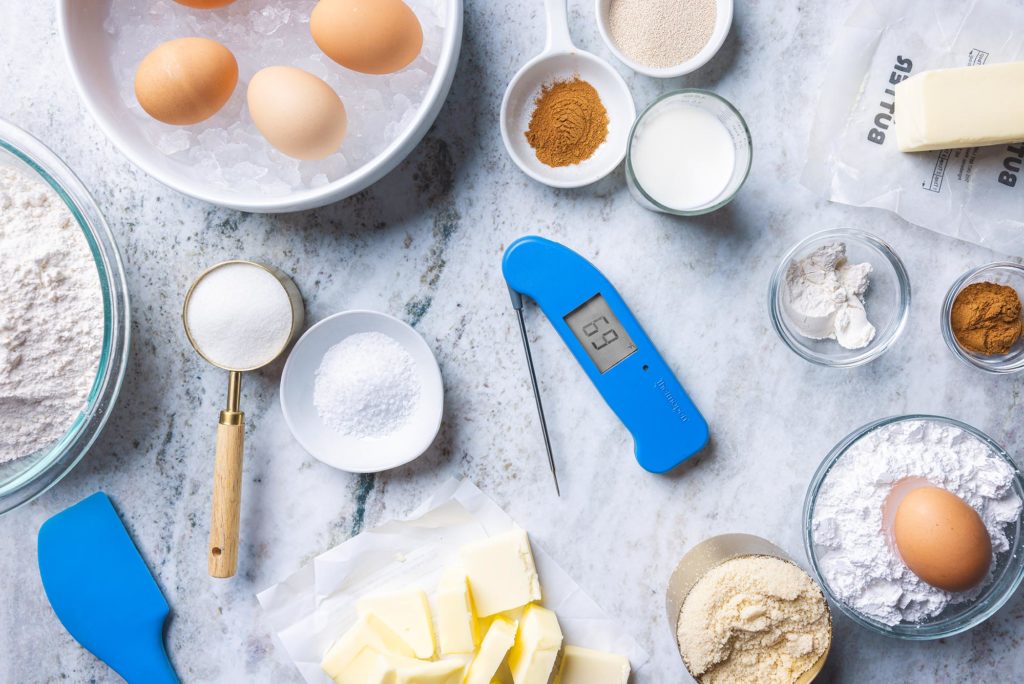
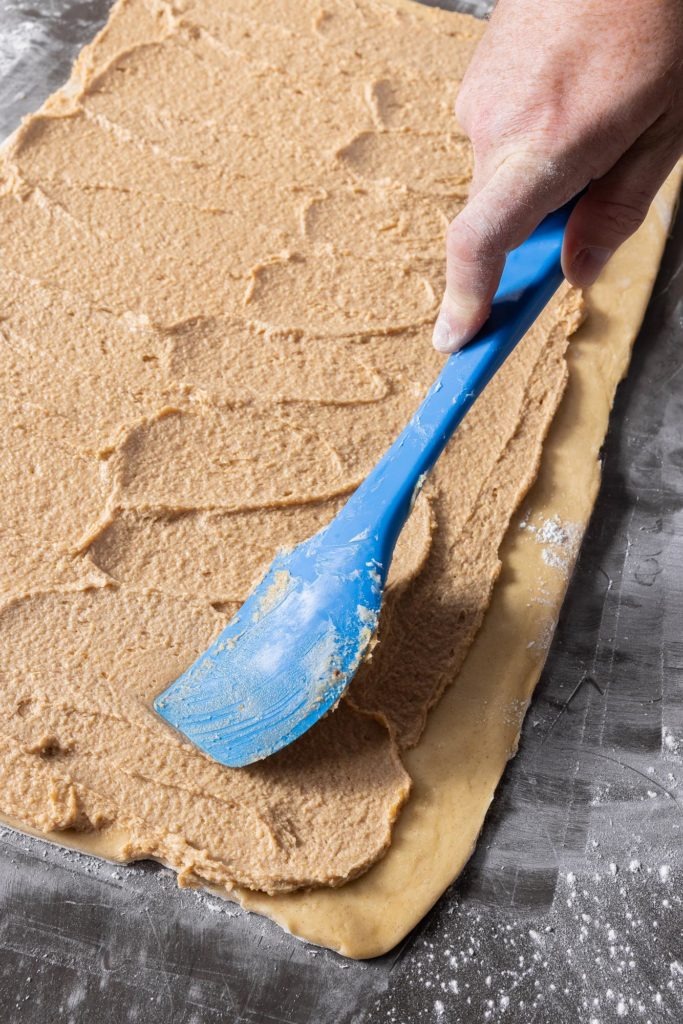
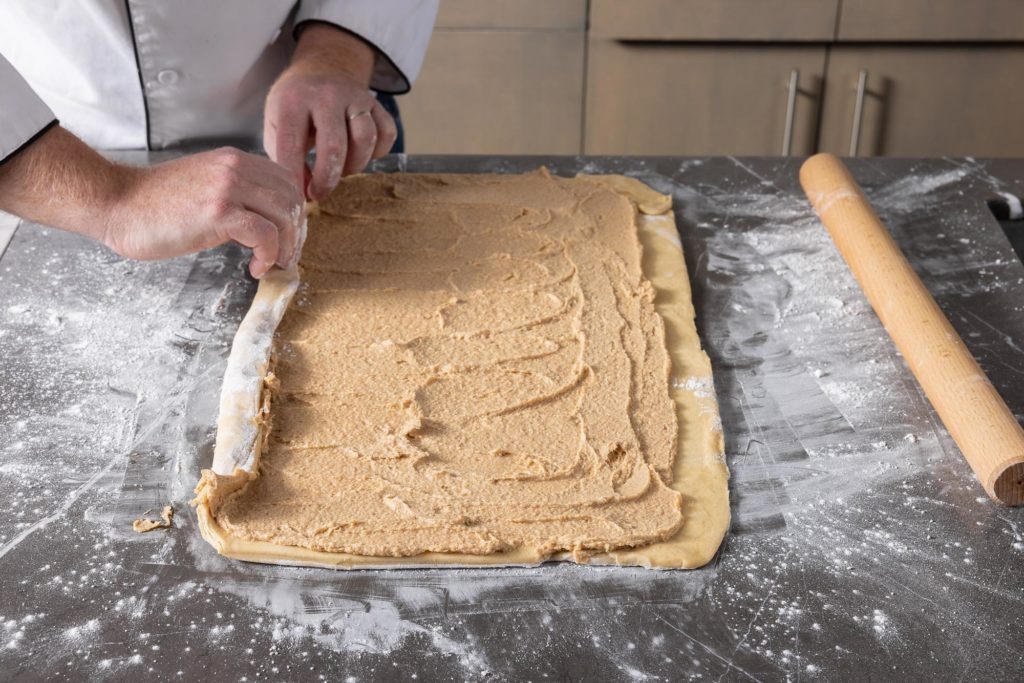
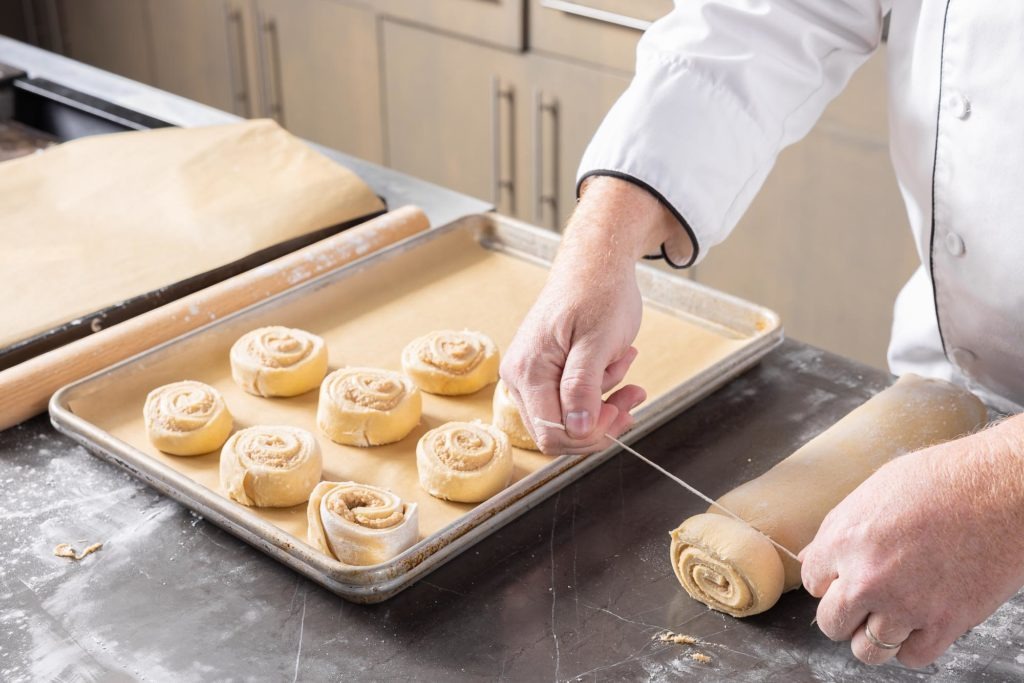
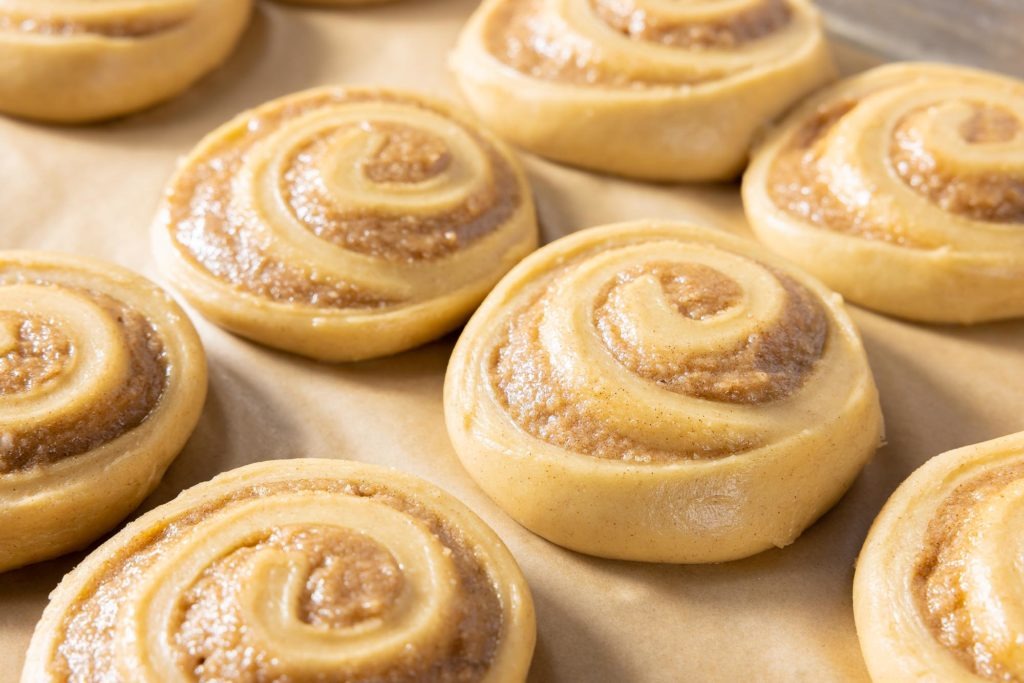

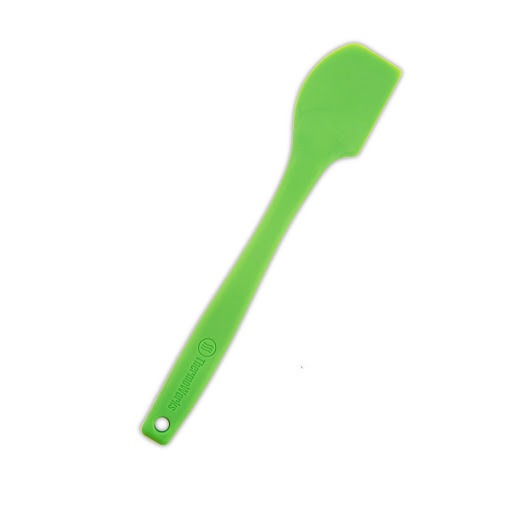

doug wildoner says
What a shame…. looked like a great recipe. How sad that you either deleted or forgot to insert the amount of butter necessary to create the cinnamon filling as based on the Almond Cream!
Kim says
Doug,
Thank you for the catch! The amount of butter in the filling has been updated.
Merry Christmas!
-Kim
Sam says
Could you please supply measurements in ounces or grams when featuring baking recipes.
Weight measurements remove a few of the variables and will increase the chance of success for those of use trying new recipes.
Kim says
Sam,
Metric measurements have been added.
Thanks!
-Kim
StuKin says
I haven’t tried this yet, but I plan to soon. Gotta love the fact that changes/corrections are published quickly to recipes so that they’re are actually usable.
Is there a site where all of these recipes are available in one place for download as one big file? I’ve been saving them as they’re published, but I know I’m missing some.
Thermoworks is THE BEST! Great equipment, great information, great company.
Martin says
Wow! thanks for wanting all of them! sadly we don’t have a database download…but maybe we should consider something like that for the futre!